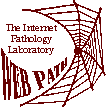| Acanthocyte | Cell with irregular, long, asymmetrical projections; sporadically seen with severe liver disease or post-splenectomy; seen with rare disorder of abetalipoproteinemia
|
| Anisocytosis | Variation in size of RBC's
|
| Babesiosis | Similar to ring forms of malaria
|
| Basophilic stippling | Small aggregates of RNA are seen as small blue dots in the RBC; fine stippling may be a feature of reticulocytes; coarse stippling can appear with toxic marrow damage, myelodysplasia, and thalassemias
|
| Elliptocyte | Elongated, elliptical cell; non-specific when occasionally seen; rare disorder of hereditary elliptocytosis
|
| Heinz body | Precipitated Hgb seen as a perimembranous blue dot only after supravital staining; seen with some hemoglobinopathies
|
| Howell-Jolly body | Small, round deeply basophilic nuclear remnant; seen when spleen is absent
|
| Hypochromia | Cells with decreased MCH, typical of iron deficiency
|
| Macrocytosis | Cells with increased MCV, typical of megaloblastic anemias
|
| Malaria | Plasmodium infection seen as "ring forms", stippling, and gametocytes, depending upon the species
|
| Microcytosis | Cells with decreased MCV, typical of iron deficiency anemia and thalassemias
|
| Pappenheimer body | Multiple, tiny iron containing granular blue dots; seen when spleen is absent and with iron overload
|
| Poikilocytosis | Variation in shape of RBC's
|
| Polychromatophilia | The bluish tint to young RBC's with high RNA content
|
| Reticulocyte | Young RBC's with increased RNA content that can be precipitated by supravital staining for identification and enumeration
|
| Rouleaux | Linear aggregation of RBC's that resembles a stack of coins; seen when surface charge is reduced with increased serum protein, particularly increased fibrinogen or globulin
|
| Sideroblast | Non-nucleated RBC with stainable iron
|
| Spherocyte | Small, round dense cell without central pallor; suggests extravascular (splenic) hemolysis in previously normal persons; with hereditary spherocytosis there is increased osmotic fragility
|
| Schistocyte | Fragmented, irregularly shaped seen with intravascular hemolysis such as microangiopathic hemolytic anemias (DIC, TTP). A variant called a "helmet cell" appears cut in half
|
| Sickle cell | Curved, banana-shaped cell with pointed ends found in sickle cell disease from aggregation of Hgb S
|
| Stomatocyte | Cell with slit-like central pallor; occasional stomatocytes are non-specific or an artefact; many are seen with rare hereditary stomatocytosis
|
| Target cell | Cell with central and peripheral staining with intervening pallor due to increased redundancy of RBC membrane; seen with liver disease, in some thalassemias, and with Hgb C
|
| Tear drop cell | Cell pinched at one end, prominent in myelofibrosis and myelophthisic conditions
|
 Return to the tutorial menu.
Return to the tutorial menu.